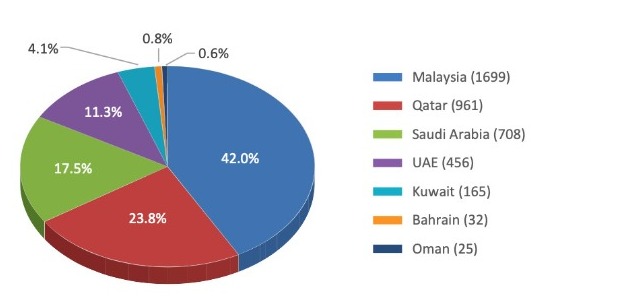In September 2025, Nepal witnessed one of its most significant youth-led uprisings in recent memory. Branded by global media as the “GenZ Revolt”, thousands of young Nepalis took to the streets demanding change. The unrest began after the government imposed a ban on more than 25 social media platforms but quickly escalated into a broader movement against corruption, unemployment, and lack of opportunities.
This blog explores the economic triggers, job crisis, and frustrations fueling Nepal’s Gen Z, the implications for its political system, and what it means for India-Nepal relations.

The Trigger : Social Media Ban
- On September 8, 2025, the government blocked platforms like TikTok, Facebook, Instagram, and X (formerly Twitter), citing regulatory compliance issues.
- For Gen Z, who live and express themselves digitally, this was seen as an attack on free speech.
- Protests erupted in Kathmandu and quickly spread across major cities.
Social Media Market Share in Nepal, August 2025
| Platforms | Market Share |
| 87.8% | |
| X (Formerly Twitter) | 6.13% |
| YouTube | 5.46% |
| 0.63% | |
| 0.53% | |
| 0.12% |
(Source: StatCounter)
According to Al Jazeera and India Today, police used tear gas, rubber bullets, and even live rounds. The violence left at least 19 people dead and hundreds injured. The government later lifted the ban, but by then, the protests had become much bigger than the original cause.
The Economic Reality Behind the Protests
Nepal’s youth are not just angry about internet restrictions. They are frustrated with an economy that doesn’t deliver.
Key Economic Challenges
Unemployment Crisis
Around 20% of youth are unemployed, according to various reports from the World Bank, Trading Economics, and National Planning Commission of Nepal.
Migration: Necessity not a Choice
Every year, nearly 3.5 million young Nepalis migrate abroad, mainly to Gulf nations and Malaysia, for low-paying jobs. Around 14% of the Nepalese population live abroad.
This trend is driven by lack of domestic employment opportunities, economic uncertainty, politically unstable situation, and remittances that form a significant portion of Nepal’s GDP of Nepal.

(Source: Nepal Times)
Slow Growth
Nepal’s GDP growth slowed to around 3.5% in 2024-25, below the 6% needed to create enough jobs.
Corruption
Ranked 108th out of 180 countries in Transparency International’s 2024 index, corruption undermines trust in governance.
The Frustration of a Generation: What GenZ Needs.
Gen Z in Nepal is different from previous generations. They are;
Digitally Connected: Most young Nepalis use social media as their primary source of news, networking, and activism.
Globally Aware: They see opportunities abroad but feel trapped in a stagnant domestic economy.
Politically Disillusioned: Many feel that the same old political elites recycle power without delivering change.
Voices of Change from the Streets of Nepal
- “We don’t want to migrate. We want jobs here at home,” a 22-year-old protester told The Kathmandu Post.
- “Corruption has stolen our future,” another youth shouted during a rally in Lalitpur, as reported by Setopati.
The Role of Corruption and Governance behind GenZ Revolt
- Nepal’s Parliament has faced frequent deadlocks and instability, with multiple governments in short spans.
- High-profile corruption scandals (linked to infrastructure contracts and foreign aid) have eroded faith in leaders.
- The resignation of Home Minister Ramesh Lekhak during the protests shows that pressure from Gen Z is already shaking the system.
India-Nepal Relations: Why It Matters.
The unrest in Nepal is closely watched by India, its largest neighbor and trading partner.
- Economic Ties: India accounts for nearly 65% of Nepal’s trade. Prolonged instability could disrupt supply chains.
- Migration Link: Millions of Nepalis work in India under open-border arrangements.
- Strategic Balance: China is also watching closely. If India is seen as unsupportive, youth sentiment could shift towards Beijing.
For India, supporting Nepal’s stability while respecting youth aspirations is crucial.
What Lies Ahead for Nepal’s Gen Z?
The Gen Z Revolt is more than a protest, it is a generational awakening. Possible outcomes include:
- Policy Reforms: Pressure for job creation, anti-corruption measures, and better governance.
- Political Shake-up: Younger leaders may emerge, challenging old parties.
- Digital Freedom: Attempts to restrict the internet may backfire, as seen in this revolt.
Developments in Nepal As We Speak (Write)- 13th September 2025
- Nepal’s President Ramchandra Paudel dissolved parliament and declared fresh elections for March 5, 2026, after a week of violent unrest.
- The country welcomed Sushila Karki as Nepal’s first woman Prime Minister, leading the interim government.
- Indian PM Narendra Modi congratulated Karki, expressing that India stands committed to Nepal’s peace, progress, and prosperity.
(Source: Indian Express)
Conclusion
Nepal’s Gen Z is not just demanding unbanned social media, it is demanding a new social contract. Jobs, accountability, and dignity are at the heart of this movement. For Nepal’s political class, the message is clear: ignore the youth at your peril.
Frequently Asked Questions
What is the Gen Z Revolt in Nepal?
It refers to the youth-led protests in September 2025, triggered by a social media ban but fueled by deeper issues like unemployment, corruption, and poor governance.
How many people have died in the Nepal protests?
Reports from Al Jazeera and Human Rights Watch confirm at least 19 deaths and hundreds injured due to police crackdowns.
Why is youth unemployment such a big issue in Nepal?
With limited industries and over-reliance on remittances, Nepal struggles to create enough jobs for its graduates, forcing many to migrate.
How does this unrest affect India?
As Nepal’s largest trade partner and open-border neighbor, India faces potential spillover effects in migration, security, and regional stability.
What can Nepal’s government do to address Gen Z frustrations?
Invest in job creation, curb corruption, ensure digital freedoms, and open up political space for youth participation.
About the Author
I’m Biswajit Singh—a storyteller at the crossroads of business, technology, and current affairs. With a Master’s in Mass Communication and English Literature and 8+ years in SEO content writing, I craft narratives that decode AI, ML, digital trends, and global shifts. My mission: turning complex ideas into content that informs, engages, and inspires.
